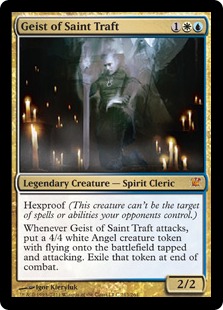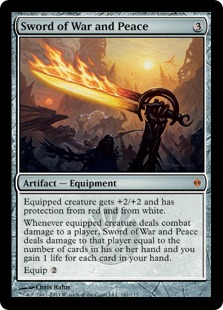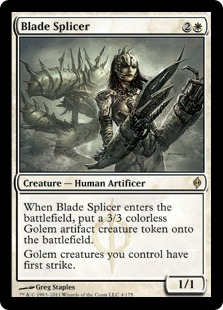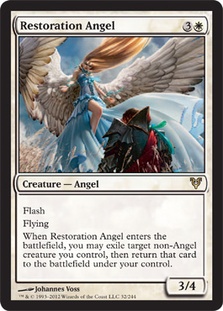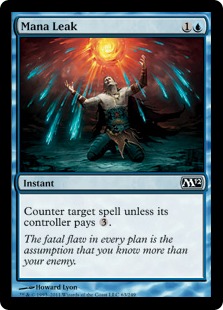This article was originally going to be titled “Why Delver Isn’t Good” or something similar, but even I realize that is blatantly wrong. Delver is good and saying otherwise is just deluding myself. There is no way it isn’t given the results it has posted.
That said, it is not the deck for me. My results and my experience testing with the deck for almost half a year confirm this.
When I play Delver, something about how the deck is working feels wrong. Before it was Invisible Stalker, but even without that card I feel uncomfortable playing the deck. Normally I would just bite the bullet and try to learn how to do this, but this format isn’t a good place to learn. The decks are just too fast and brutal to get a good hang of fundamentals between matches.
I’ve thought about this for a while, and my problem with Delver is that it isn’t Caw-Blade or Faeries despite all the comparisons. This isn’t necessarily a bad thing, but I’ve noticed more and more that Delver is just not how I want to play Magic, while the other two are.
Faeries and Caw-Blade were built on a basis of tons of card with high utility coming together to allow you full control of a game. With Delver, you have a lot of low cost cards that can play out in a similar interchangeable manner, but the real utility is missing. Some of your cards are very bimodal in quality; they are either absolutely insane or stone blanks. While this can be fine, in Delver I find it to be extremely awkward. This is magnified as people adapt to the deck to punish your situational cards.
The way this occurs in Delver is different than usual. Most of the time when you think of a deck having issues with situational cards, you think of things like drawing Ancient Grudges when your opponent doesn’t play their Sword of War and Peace. When you lose, you flash your hand of three blanks and complain about them not playing the card you had the answers for.
Delver doesn’t have strictly situational cards like that in significant quantities. At most there was one Divine Offering and two Gut Shots in the maindeck, and even then you had Ponder to filter cards. Your individual cards are also powerful threats, negating how much grinding you are doing and how much virtual card disadvantage matters. When Geist of Saint Traft and Insectile Aberration at hacking away at your opponent’s life total, that one blank doesn’t matter much. In the traditional situation of drawing blanks grinding late, Delver was perfectly fine.
The issue here is a bit more subtle.
Delver is a tempo deck through and through. To use some contentious terms, it is definitely not a hybrid control deck no matter how hard people try to sideboard into one. You have some cards that are very good at both pushing and defending, but you have enough that aren’t that you are often put into scenarios where defense is impractical or impossible. Specifically, you have Delver of Secrets, Geist of Saint Traft, and the sometimes present Sword of War and Peace.
All of these cards are extremely powerful, aggressive threats, but I would rather be playing completely reliable threats. Delver, Geist, and Sword change too readily from unbeatable to unplayable depending on hard to influence factors like the matchup, what cards your opponent has cast, and the actual top of your library. When the deck first broke through, it didn’t matter as much as these cards were just handing out free wins left and right, but the metagame is shifting to answer these threats and expose their inconsistencies.
Delver of Secrets is always tied to random chance or if you have a Ponder. You get free wins from flips sometimes, but you also get free losses from playing Fugitive Wizard. This isn’t an issue by itself as the expected value on a natural Delver is very good. Given the usual twenty or so instants, your average blind flip is attacking with a 3/2 flier on turn 4, putting your expected damage output at Serendib Efreet plus a couple free points from the 1/1 side. Still, that 30% of the time you run below the curve on natural triggers is going to cost you games. This is compounded by people expecting the early 3/2 flier and making decisions to minimize its power. Notably this occurs in the mirror, where if a player mulligans to beat an early Delver they can easily extend the game for a control finish.
With Geist of Saint Traft, the problem is entirely that people are ready. Geist is unreal if it ever connects, but doing so is getting increasingly more difficult. Phantasmal Image is seeing more and more play, as are hexproof blockers. Blade Splicer is surprisingly obnoxious, despite how well Vapor Snag matches up against it. The only remotely viable deck I can think of that doesn’t reliably answer Geist is Zombies, and that deck just crashes through and races.
(Aside: If you are playing Geist of Saint Traft in the near future, I would strongly consider adding more Mutagenic Growths to your deck than you currently have. The card makes Geist match up well against almost all of the current ways to hold it back. Your Geist beats Restoration Angel heads up, survives non-miraculous Bonfire of the Damneds with ease, and can swing into a Huntmaster of the Fells. You can even serve into a turn 3 Dungrove Elder and win the fight on the play or trade on the draw. The trade might not seem exceptional, but realize Delver has no other way to kill a Dungrove Elder. On second thought, that last part is marginally false: you can Mutagenic Growth + Restoration Angel ambush it. The only thing it doesn’t solve is Phantasmal Image, but what more do you want from a free spell?)
Sword of War and Peace has a matchup dependent power level and just feels like preboarding. Some decks can never beat a Sword, but some decks actually don’t care. I don’t even like it much in the mirror as it is fairly easy to beat an opposing Sword on tempo with Vapor Snags, though if the game starts getting attrition based it is often hard to apply the necessary pressure to do so. That said, the Sword player is still on a clock to use it. Once you empty your hand, they are looking at a more expensive Vulshok Morningstar.
When I play Delver, it infuriates me to no end when I see a range of hands with these cards. You know that if your opponent has specific answers they are going to completely destroy you, but you can’t realistically mulligan because if they don’t have it you are going to crush them.
I want my cards to be always good. I want them to give me options on offense and defense and not force my hand into attacking.
I want something like this:
Creatures (17)
Lands (18)
Spells (25)

I’ll leave the specifics of this deck up to Mike. I want to focus on why I would play this deck. What makes this what I want?
This deck can still push when it wants to. Blade Splicer is by no means a shabby clock, and the curve of it into Restoration Angel or Phantasmal Image is a very powerful, aggressive start. Maybe not as fast as a turn 2 Snapping Drake, but still good enough.
Your cards are all utility on offense and defense, except Forbidden Alchemy which is borderline at best. Sun Titan might not look the aggro type, but he closes hard.
Still, there is one loose thread I feel obligated to address.
See, every deck in this format is playing Cavern of Souls. Or at least they should be. Solar Flare and Wolf Run Ramp naming Giants, G/R and W/B naming Humans, and Zombies naming the obvious. I board out some number of this card in well over half my matches with any Snapcaster deck featuring four.
Why is it even in the deck? I’ve talked about not wanting situational cards, and Leak is clearly one of them. I honestly have no idea what it’s doing in the main.
There’s an argument to be made about having enough cards to get value off Snapcaster Mage, but I don’t buy that with seven cantrips in the deck as well as all the removal. Presumably some number of cut Mana Leaks, if not all, would translate into other Snapcaster targets. I’m not sure what the minimum number of targets for Snapcaster Mage is to make it good, but it definitely is closer to the twelve non-Leak cards this deck plays than the 20 instants and sorceries needed for Delver of Secrets.
You can argue that there wouldn’t be enough low-drops otherwise, but two isn’t the best place in Standard. Leak on the play answers only other mediocre cards. It’s fine on the draw against the prevalent and powerful three-drops of the format, but that is another layer of power level swings that I don’t want to handle. Do you really want to play a card that is only good when your opponent is on the play and doesn’t have a Cavern of Souls?
I don’t even want the card where it “should be good”: Wolf Run Ramp. They can easily get to nine mana or a Cavern of Souls and blank it. I’ve lost multiple matches to Wolf Run playing Delver, and the only thing I’ve ever wanted to Mana Leak is a Bonfire of the Damned for two.
The only real argument is how absurd Leak + Snapcaster is against non-Cavern decks. I played against a W/B Tokens deck in the SCG Standard Open this past weekend and demolished it because I Time Walked him four times in a row with this combo. Still, at that point why not just board it for that small section of the field. When you play against Shaheen’s million five-drops control deck, you can just board into five counters and win.
I would start with what Gerry did with Delver and go down to three. If I went below that, it would be to play zero.
Finally, some notes based on playing a similar list at the SCG Standard Open in Indianapolis. Props to Chris Andersen for providing me with the list as well as physically filling out my deck registration form and 7-1ing the SCG Invitational with the same 75.
- Against Delver be prepared to answer an early Delver flip. As with the mirror, if that doesn’t happen early the game will drag on as long as you want it to. Your deck is the better control deck; play it as such.
- Sword of War and Peace deserves your respect and then some. Without the pure aggro threats, tempoing it out is no longer a legitimate plan. You have to actually kill it. I’m not sure what the right removal split is, but I would want at least three answers to the card postboard. Often it is the only way decks featuring it can beat you, especially when the deck in question is G/R.
- Gideon Jura is a good end game threat. It won’t win a game you are super far behind in, but it seals the deal in any one that is remotely close. I would at the least sideboard it. The combination of it and Restoration Angel is extremely powerful. I had multiple instances where I got to attack with a Gideon low on counters, reset it with an Angel Blink, and +2 their remaining creatures into a 3/4 blocker.
P.S.: For those interested in a tournament report, here is an abridged version.
I played Delver in Standard. My list was stock as can be, with only a few marginal differences from LSV’s winning list from the Oakland World Cup Qualifier last weekend.
Creatures (16)
Lands (13)
Spells (31)

Round 1 I played the Delver mirror.
Game 1 he pulled ahead on cards with Snapcaster Mage on Ponder and a Moorland Haunt that forced my Vapor Snags. I made a misplay in the end game and ran into his multiple Mana Leaks stuck in hand, turning a board state where I was likely dead to one where I surely was. Given the fact he had done almost nothing for multiple turns, it should have been obvious what his hand was.
Game 2 my opponent drew exceptionally well after I Probed him, but that’s not the whole story. I failed to notice the Dismember he cast was non-foil and played into the second one I should have known about. Yet again I threw away a small chance at victory due to a misplay.
0-1
Round 2 I played against old school Wolf Run Green with Dungrove Elders.
Game 1 I Gut Shotted a Birds on turn 1 and followed up with a Snapcaster for my Gut Shot and a Dismember on his next two on turn 2. I assumed triple Birds indicated a mana light hand from G/R that I could easily stunt off the critical four spot. His subsequent Dungrove Elder proceeded to crush me, though I think with the extra life from taking a different line I could have been in the game. It’s possible I should have read him for being Dungrove Green from his first two lands being Forests, but that’s a different debate.
Game 2 I flipped two Delvers early and got the free win. Easy game.
Game 3 I kept a hand I probably should have reconsidered: Restoration Angel, Geist of Saint Traft, two cantrips, and lands. It wasn’t fast enough to really handle a Dungrove Elder early, and I couldn’t interact with his mana guys to slow him down. I ended up dying to a Dungrove Elder equipped with Sword of War and Peace.
0-2
Round 3 I played against Wolf Run Ramp.
Game 1 he won the die roll and my Probe revealed a hand of Rampant Growth, Solemn Simulacrum, Whipflare, and lands including Cavern of Souls. My subsequent turn I Snapcastered Probe to see his draw step had yielded Primeval Titan. I was able to Dismember plus Gut Shot the 6/6 and start to battle back, but he drew an Inferno Titan and I promptly died.
Game 2 I had double Delver early, but neither flipped. Without a clock, my opponent was able to sit back, build up to an uncounterable Titan, and kill me.
0-3
Round 4 was another mirror.
I played miserably due to tilt, but he played worse so I exited Standard barely alive.
1-3
In Legacy, I went with the old standby of Tendrils, specifically TES. The only deckbuilding decision I made was going with Silence over Orim’s Chant due to the stock Sneak and Show list having Misdirection and Leyline of Sanctity. Chant targets a player; Silence doesn’t. I was slightly concerned about Reanimator, but my morning testing against Brian DeMars ended at 5-2 or 6-1 in my favor, leaving my extremely confident. My Duresses were especially potent, Storm goldfished faster than Reanimator, and the recent list with only eight actual Reanimation spells was especially prone to not having it on turn 2.
Lands (13)
Spells (47)

Round 5 I was matched against Reanimator.
Game 1 I unfortunately gave my opponent a turn 2 and found myself facing down a Reanimated Griselbrand. I went for it with an Ad Nauseam, and my opponent failed to find a Force of Will in his seven cards. His untapped Island translated into a last chance Brainstorm, and that hit. After the match I did the math, and I was somewhere around 30-40% to win from that board state. Not bad for facing down the nut draw.
Game 2 I Duressed his only relevant card on turn 1 and drew half my deck on turn 3.
Game 3 my opponent mulled to five but ended up ripping the land to go with his turn 1 Entomb and in hand Exhume to make a Griselbrand. His draws yielded a Force of Will for my attempt to combo, only this time it was fourteen cards instead of seven.
1-4 and drop. You win some, you lose some.
For those attending, I’ll see you at the SCG Open Series this weekend in Detroit. I’m excited for my hometown to be hosting its first major event since 2005. To put things in context, the format was Kamigawa Limited, and I won a JSS Qualifier held there by Spectral Shifting a Boil. Go ahead and read that one. Hopefully it won’t be another seven years before the next event is held here.


